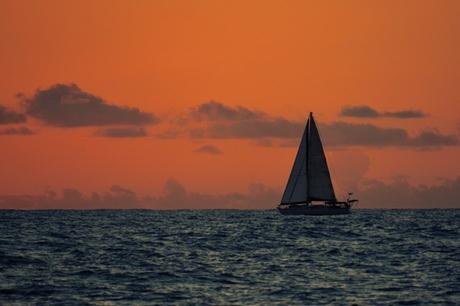
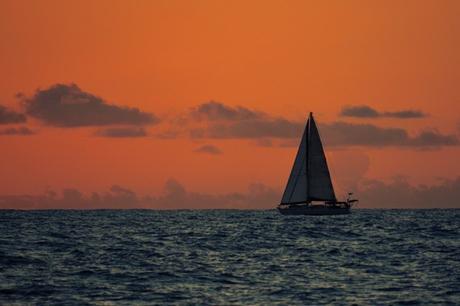
There’s a problem: many cruisers think that sailing performance isn’t important. Hey, cruising is about slowing down, right?! But dismissing performance is poor seamanship. After some years of listening to cruisers disregard performance and gripe about slow passages, it dawned on me that confusion is to blame.
Our good friend William demonstrated this last year during a fun race in Madagascar. William is a good sailor with much blue water cruising experience. He doesn’t race, but his competitive side, or maybe his social side, was piqued by party and prizes to follow the competition. With his racing cap on he chose a bold spinnaker start while single-handing. It didn’t go well. The gun cracked and his spinnaker tangled, slipped, and dipped…he did not have a good race. On passage William is slow and deliberate when setting a spinnaker, a pace that isn’t very racer-like but ends with a performance boost. Had he stuck with this instead of confusing performance and racing, he would’ve had more to celebrate at the party.
To clarify this issue, let’s forget all about performance; and instead, talk about “efficient sailing.” A rabbit in a bunny suit is still a rabbit, so what’s the point? Comfort and safety come with avoiding or minimizing bad weather, and stress comes from contemplating a three day passage when weather windows only last for two days. Efficient sailing is getting from A to B with minimal effort. What could be more appealing to a cruiser than minimal effort!
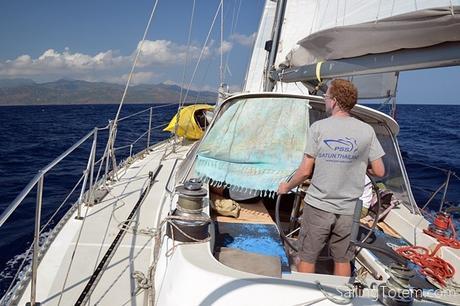
Making landfall in Comoros, Indian Ocean
Sail trim
Racing sailors are pedantic about sail trim. Constant adjustments can yield subtle gains that show when measuring against competitors. We’re not interested in subtle gains. Reasonable sail trim takes no more time than bad sail trim, but yields better speed with less wear and tear to sails.
For example, when reaching and running, a boom vang locks the boom from lifting and dropping due to changing wind pressure on the mainsail. This may seem insignificant, but not using a vang slows you down and will cost you money in repairing a mainsail chafed by rubbing against rigging.
Another example is headsail trim. Sheet blocks are often set for reasonable trim going upwind, which fine, except that most of the time cruisers aren’t sailing upwind. When using an upwind sheeting point for reaching and running, the upper portion of a headsail twists to leeward, spilling wind causing the upper leech to flap. A barber hauler is an easy way to trim the headsail correctly for broader wind angles. This gives a considerable boat speed boost that can be 10 miles and more per day.
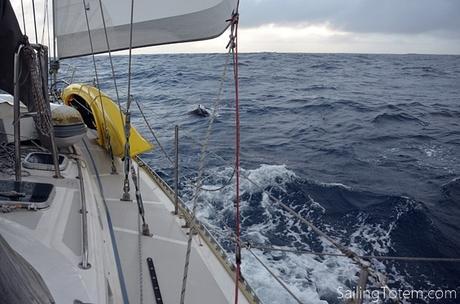
Both barber hauler and sheet are used for max efficiency at the wind angle
Sail handling
Racing sailors are well practiced at sail handling for fast transitions. Fast is usually not important or practical for short-handed cruisers, like our friend above. Efficient sail handling from a well setup boat, practice, and good crew communication reduces crew risks and equipment breakages.
Step one is setting up the boat to make sail handling easier. Cruising boats are usually reasonably well set up, but it takes time on the water to learn what works well and what needs improvement. Friction causes the most trouble. Friction makes you weak, and swear like a sailor. I installed a Harken furling system for cruising friends in Singapore. The next day they had words with me because furling was harder than ever. I went back to their boat and tested each furling line guide blocks. Only one of them actually turned, and the rest were easily fixed with fresh water and silicone spray.
Keep winches, blocks, and sheaves in good order. Watch for line chafe and metal fatigue. And give thought to unplanned sail handling events – they happen. When Totem was ghosting along the Pacific ITCZ, the heavy duty stainless steel pad eye securing the mainsheet to the boom sheared off. The part was less than a year old, and failed from slatting force. By chance, I had installed a webbing strop around the boom just in case such a thing happened. The mainsheet was reattached in just a couple minutes.
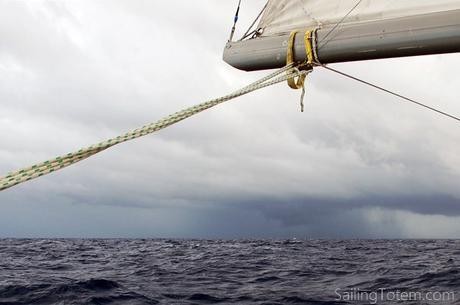
Pacific, between Mexico and Marquesas. Bonus squall. Rather undesirable twist in the mainsheet….
Step two of efficient sail handling is matching sails to the conditions. This may seem obvious, but it’s common to see people raise the anchor and hoist full sails; then outside of the protected anchorage, bigger wind hits and they scramble to reef the main. This is almost like sport in the eastern Caribbean this spring watching boats poke out from the lee and into the channel between islands. Start the day with a weather forecast and a few moments of observation before getting underway, and don’t forget the impact of geography.
Once underway, reducing sail area is all about observation and timing. In 20 knots of true wind, I can reef our mainsail on my own in 2 minutes –less if more motivated by approaching squall. In 30 knots it takes at least twice as long. Monitoring wind speed and watching for obvious changes (like squalls) and subtle changes (such as increasing gusts) gives you time to adjust sails when it’s still easy.
Approaching the South African coast last November, we expected landfall 6 to 12 hours ahead of forecasted bad weather. With 20 miles remaining of the 1,000 mile trip, we were sailing in gentle conditions with a perfect sunrise, and feeling good. Then I looked up. Above a thin layer of clouds going our way, clouds whipped along in the opposite direction. Bad news: the southerly buster came early! Engine on, we prepared for strong headwinds. At 7 miles to go, wind was 25 to 30 knots on the nose and against the strong Aghulas current. Waves piled up with no gap between them, and our speed dropped under two knots bashing into them. It was a tedious few hours getting in, but each additional hour out there would have been worse.
This post was contributed by Jamie, who shares his more technical sailing experience from time to time. It’s really two legs on a three-legged stool, because routing is as important to efficient passagemaking as sail trim and sail handling…that post will have to come later.

